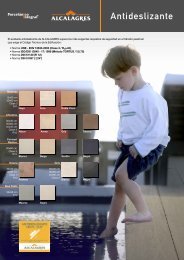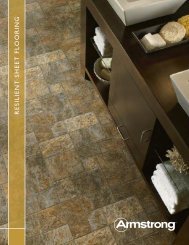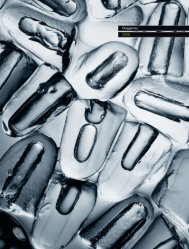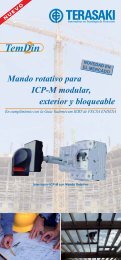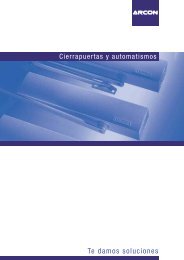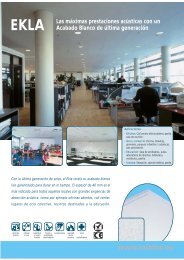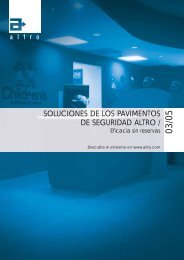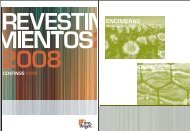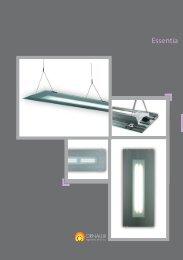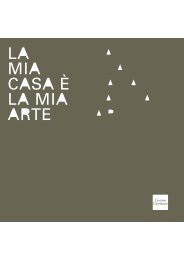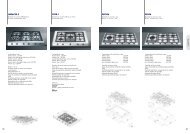manual de colocación de baldosas cerámicas - Habitissimo
manual de colocación de baldosas cerámicas - Habitissimo
manual de colocación de baldosas cerámicas - Habitissimo
Create successful ePaper yourself
Turn your PDF publications into a flip-book with our unique Google optimized e-Paper software.
Types:<br />
> CEMENT ADHESIVES.<br />
Some of the bonding materials most commonly used on the market today are: Cement adhesives. These consist of a main bin<strong>de</strong>r (Portland cement)<br />
and sands and other additives that improve the adhesive’s characteristics. Cement adhesives inclu<strong>de</strong>:<br />
> Conventional Glue Mortars.<br />
Organic products are ad<strong>de</strong>d to the mortar to<br />
improve its elastic and water-retaining properties,<br />
thereby remedying the failings of traditional<br />
mortar. These are used only for indoor surfaces.<br />
Class C1 according to EN 12004.<br />
> Glue Mortars with Casein.<br />
These are used especially on tile-laying surfaces<br />
ma<strong>de</strong> of plaster and/or gypsum. Class C2E<br />
according to EN 12004.<br />
> High-specification Glue Mortars.<br />
These can contain up to approximately 2% of<br />
thermoplastic resins to improve adhesion. They<br />
are suitable for interiors and outdoor floor<br />
surfaces. Class C2 according to EN 12004.<br />
> Glue Mortars with Mixed Bin<strong>de</strong>rs.<br />
These usually contain more than 2% thermoplastic<br />
resins, either incorporated or in the form of a<br />
water-based dispersant to add to the pow<strong>de</strong>r.<br />
These glue mortars have improved adhesion,<br />
<strong>de</strong>formability, resistance, etc., and are the best<br />
products to use for <strong>de</strong>manding applications. Class<br />
C2E and C2TE according to EN 12004.<br />
> CEMENT ADHESIVES.<br />
ADVANTAGES DRAWBACKS<br />
USES<br />
> Easy to use > Limited adherence<br />
> Indoor floors<br />
> Indoor use only<br />
> Rigidity<br />
> Not recommen<strong>de</strong>d for tiles with low<br />
water absorption<br />
> Indoor walls<br />
> Easy to use<br />
> I<strong>de</strong>al for plaster and/or gypsum<br />
base<br />
> Deformable<br />
> Easy to use<br />
> Excellent adhesion<br />
> Easy to use<br />
> Excellent adhesion<br />
> Resistant to damp<br />
> Deformable<br />
> Suitable for tiles with no<br />
absorption<br />
> Suitable for faca<strong>de</strong>s<br />
> Limited adherence<br />
> Not recommen<strong>de</strong>d for tiles with<br />
water absorption of less than 1%<br />
> Rigidity<br />
> A <strong>de</strong>gree of rigidity<br />
> Not recommen<strong>de</strong>d for tiles with<br />
water absorption of less than 1%<br />
> Indoor walls<br />
> Indoor floors<br />
> Outdoor floors<br />
> Indoor walls<br />
> Indoor floors<br />
> Outdoor floors<br />
> Indoor walls<br />
> Outdoor walls<br />
Some of the bonding materials most commonly used on the market today are: Cement adhesives<br />
These consist of a main bin<strong>de</strong>r (Portland cement) and sands and other additives that improve the adhesive’s characteristics. Cement adhesives<br />
inclu<strong>de</strong>:<br />
> REACTION ADHESIVES<br />
ADVANTAGES DRAWBACKS<br />
USES<br />
> Easy to use<br />
> Excellent adhesion<br />
> Deformable<br />
> Suitable for any kind of<br />
tile-laying surface<br />
> Suitable for tiles with no<br />
absorption<br />
> Not suitable for large-sized tiles<br />
> Low resistance to contact with water<br />
> Indoor walls<br />
These compounds are based on synthetic resins that har<strong>de</strong>n due to the chemical reaction between the various components. They usually have<br />
excellent specifications, plus the resins provi<strong>de</strong> special technical characteristics. However, their main drawback is that all the component resins<br />
must be mixed, meaning that they must be carefully handled. Type R according to EN 12004.<br />
ADVANTAGES DRAWBACKS<br />
USES<br />
> Excellent adhesion<br />
> Mechanical resistance<br />
> Chemical resistance<br />
> Flexibility<br />
> Suitable for tiles with no<br />
absorption<br />
> Meticulous handling<br />
> The quantities of the components<br />
must be carefully measured<br />
> Indoor floors<br />
> Outdoor floors<br />
> Indoor walls<br />
> Outdoor walls<br />
* The characteristics <strong>de</strong>scribed above are typical of the products mentioned. It is always advisable to consult the manufacturer<br />
before applying a product. 07




